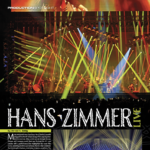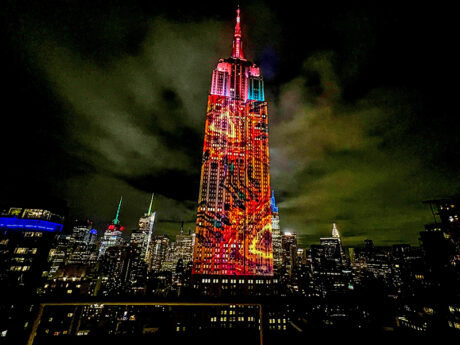
Lighting and Video Mapping the Upside Down on the Empire State Building
On an “ominously” cloudy May 26 evening in NYC the world turned upside down as a rift opened on the south side of the Empire State Building. This traffic stopping event was part of NETFLIX’s visually spectacular activation for the debut of Stranger Things 4, Vol. 1 that consisted of a light show and projection mapped ‘opening of rifts’ on 15 landmarks in 14 countries around the world. The rift projection and lighting presentation on the iconic Empire State Building (ESB) was actually a 15-minute show that looped for two hours. The effort to realize this event on the ESB epitomizes the saying ‘The devil is in the details.’ To learn more about those production details PLSN spoke with two of the companies that provided the lighting design and projection mapping solutions—Tactical Manoeuvre, LLC and PRG. They gave us some insight on the technology that captivated fans streaming around the world and New Yorkers who clogged streets and rooftops to glimpse the Upside Down.
Creative agency, Giant Spoon was tasked by NETFLIX to create and oversee the global Stranger Things activation. They in turn brought on board Superbien, a worldwide creative studio to create the content for the projection mapping. For the ESB location, PRG supplied the projection equipment and project supervision as well as audio and lighting equipment for the two official viewing locations. The lighting design for the ESB project was provided by Marc Brickman’s Tactical Manoeuvre, LLC, which has been the resident lighting designers for the ESB since 2012.
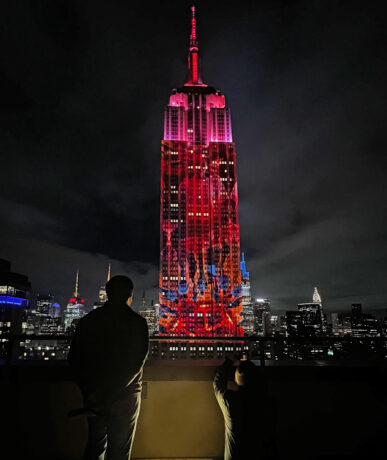
The Lighting
The Tactical Manoeuvre (TactMan) team included Creative Director, Marc Brickman, Producer, Elisha L. Griego and Lighting Director/Programmer, Dietrich Juengling. “We got the call from Giant Spoon in early April,” Griego explains when asked about their scope of work. “We designed the building lighting and designed and formulated the GPS synch system. The synch system was really the most challenging aspect because we were synching lights with the video projection, as well as audio at the two remote viewing locations. In addition to lighting designs for the ESB, we’ve done other projects with lighting and projection mapping, so we had a strong understanding of the needs of this project.”
TactMan uses a system for the lighting at the ESB that they’ve worked with over the last 10 years. “It’s an amalgamation of various things,” describes Griego. “There’s some MA equipment; there’s also proprietary software that we’ve written, and the fixtures are Signify Philips Color Kinetics from the original installation. For our pre-viz on this job, we got still storyboards from Giant Spoon. They wanted to use the color red and some of those very iconic Stranger Things’ looks. Mainly lighting took all of our cues off the video.”
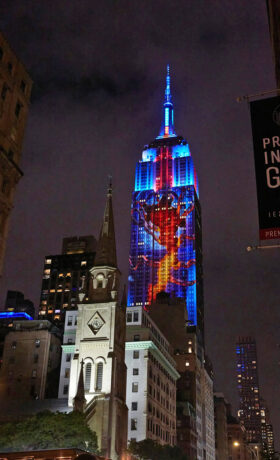
Usually, the lighting on the ESB is the star of the show; for this event “the lighting was supporting the video content,” agrees Juengling. “There were moments when lighting would take center stage a little, but primarily it was trying to capture the feel of the video to make it look consistent and help create one giant effect. Also, different this time, was that this was a 15-minute show segment, which is longer than we normally do. Normally it’s one song; three to five minutes. Here there was a lot of programming that needed to be accomplished.” Juengling has been on the TactMan lighting team for 15 years and has learned that “this building is so unique. Programming the Empire State building is far and away, not even close to programming a concert. The Empire State Building is your performer, which means if you don’t want to lose people’s attention, you got to keep the lighting active. It’s like how they make commercials, the camera cuts every five seconds. So, I always have a tremendous amount of cues on the Empire State Building than I’ve ever had on any concert or any single show. It’s just hundreds and hundreds of cues. For Stranger Things, there were times where I would use a piece of the Superbien video content to drive the lights and create moving color imagery on other parts of the building to reflect what was going on with a scene from the video.”
TactMan helpfully has a studio in the ESB. “That’s where all the equipment resides,” explains Juengling. “In this case, we had one person down by the projectors, to keep an eye on things if there were any problems, and another person in the control room who was standing by at the console ready to make any changes or deal with any issues that came up.” He points out that though it was a complex idea and longer than most ESB light shows, “this was one of the smoothest projects we’ve done with projection mapping and lighting. It was my first time working with Superbien and I was super impressed. It was a really good experience working with the entire team and all the companies involved with this project.”
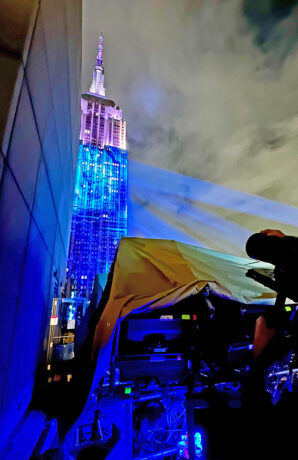
The Projection Mapping
The team from PRG’s Solution Studio on the ESB activation was led by Heather Franse, Project Development & Execution, and Senior Solutions Engineer Scott Inukai. PRG provided 46 Barco 30K laser projectors, structural design and engineering, flooring, logistics, crew, and skilled technical staff. They set up and projected from the roof of a 40-story residential building to the south of ESB. The load-in itself was perhaps one of the bigger challenges of the project since they had only a single, small service elevator to reach the roof. That meant that each projector had to be taken out of the case—as well as the structural elements, and other required tools and gear—and brought up one at a time. The PRG team also loaded-in the audio and small lighting packages to the viewing locations—and provided the important GPS clocks for TactMan to synchronize the audio and projection for the various remote locations.
“It was great to work with TactMan, who we partnered with so that the lighting and content was not only in synch, but that the colors were matched,” Franse comments. “The GPS clocks weren’t something we had used before on a project, but we were glad to be able to supply them to TactMan for the synch system that they had developed. It connected the ESB to our projection location, which was a few blocks downtown on 31st Street, as well as to the two viewing locations. It worked great to keep everything in synch.”
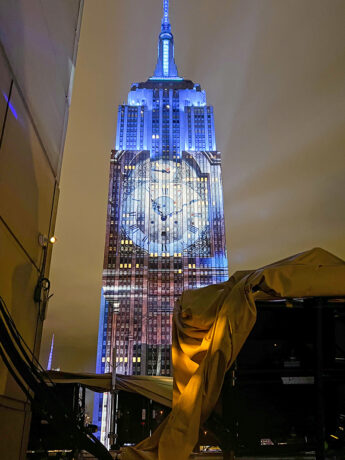
“Our scope of work also included putting together the projection system and scanning the ESB to get all the sizing, so the content could be created pixel accurate,” says Franse, “then working with Superbien to make sure that everything worked with the content as needed. With the 46 projectors, we had varying, different kinds of stacks. Some were triple stacked, some double stacked; some were mounted horizontally and some portrait. We also programmed a custom projector network control system to power on/off and switch to redundant sources as a group instead of having to manually touch the units individually.” The media servers, provided by Superbien, were Paris-based ETC Audiovisual’s Onlyview.
Franse describes one of the other challenges of working on a rooftop high over Manhattan. “Being on a rooftop, weather is always a concern,” she states. “So, we implemented a system using an anemometer to make sure that we were monitoring the wind speeds and weather throughout. We also built a structure that we knew was safe up to 45-mile-per-hour winds. We rigged a fabric covering that could be placed over the projectors. Whether or not we had to go on with some inclement weather, we were ready. Safety is always a high priority, but it was of particular concern for us being that we were on a rooftop. Even a simple piece of plywood we would use under the projectors could end up being dangerous if it blew off. We had a really tight eye on safety throughout the whole process. There was a tight timeline on this project; six weeks from the first site survey to the night of the event, so we never wanted to take any safety shortcuts. We carefully planned everything. We were lucky it was such a great team as there were a lot of entities involved in this project,” states Franse. “We were all working in very close quarters. TactMan, Superbien, Giant Spoon, and PRG all had intersecting roles and we worked together every step. We had a lot of conversations and planning, so when we got on site, everything was pretty much set.”
TactMan’s Griego summed it well by saying, “We fly under the radar most of the time, so it’s really exciting to be part of something this big; something that ripples out over social media. It is great to be walking through the streets and everybody is literally stopped with their phone pointed up looking at your work. It’s a really remarkable feeling. That’s kind of what we live for; making everybody stop and look.”
